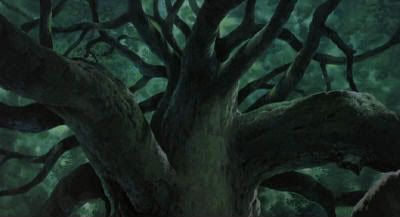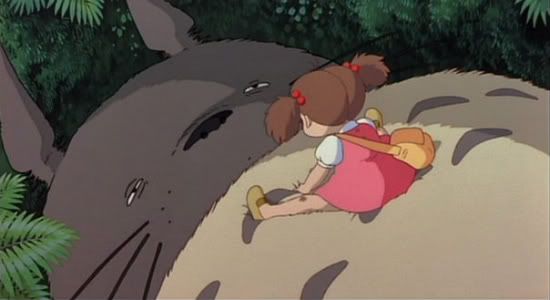|
My Neighbor
Totoro |
|
Synopsis Analysis Fortunately, the movie's virtues are not confined to the skill with which two of its characters have been crafted. There is hardly a single element included in My Neighbor Totoro that is not completely intoxicating. In a film without any real conflict, without a villain, without tensions between the girls or between them and their father, without any of the mechanisms usually used to engage the audience, Miyazaki has fashioned an enthralling experience. He captivates the viewer by bringing to life the adventurous joys and vibrant perspectives of childhood so that the viewer is transported to a marvelous, playful world he has, perhaps, not encountered for many years. As a consequence, My Neighbor Totoro is, very likely, the most successful evocation of the world of early youth ever to have been filmed. Miyazaki's skills do not, however, rest even in such a realization of the magical wonders and excitement of childhood alone, as the director has also imbued the movie with a real sense of the majesty, beauty, and mystery of the world in which we live. My Neighbor Totoro is aimed at children, there is no doubt, but, like Lewis Carroll's Alice in Wonderland, it is just as accessible to adults, who will, perhaps, enjoy it in a variety of ways children probably will not. The sensitive viewer can hardly remain blind to Miyazaki's evocations of a strange, wonderful world hidden somehow within that in which we ordinarily live, a world which, while not always visible, is not different from our own. When the director draws out the strange, deep mysteries of nature in all their awesome splendor and reminds the viewer of the enchantments of life, of the subtle beauties that are always so close at hand, if only one takes the trouble to look at them, no individual with the the ability to savor such wonders can possibly fail to be intoxicated by the marvels being shown to him. My Neighbor Totoro is a work of art, and its beauty and charm should be apparent to any person of sensitivity. The movie's loveliness is even further enhanced by the gorgeous animation with which Miyazaki brings his charming characters and numinous world to life. The forests and fields around the girls' home are rendered with loving and sensitive care, and the characters themselves are drawn in the usual attractive and engaging style preferred at Studio Ghibli. Every detail of the animation is both beautiful and inspired. My Neighbor Totoro is not an isolated aberration, however, but belongs to an evolving artistic tradition, anime. As that tradition, although still relatively new, has already developed its own canons of stylization, some knowledge of these will greatly increase the viewer's ability to enjoy the refinements of style present in the film, just as, for example, a person familiar with the stylistic conventions according to which men and women are portrayed in Ukiyo-e prints can appreciate the works of that tradition in a way a person ignorant of these cannot. Even when great artists within a given tradition have their own approaches, so that their own variations on their genre's conventions are recognizable, since they continue to work within certain ever evolving parameters, a person cannot fully appreciate their accomplishments without some knowledge of those parameters. The artists of Studio Ghibli, for example, have distinctive approaches to such things as character design, landscapes, and the like, but these approaches are guided by conventions which can clearly be situated within those of anime generally. Without some awareness of the continuities of style occurring across this wider tradition, the viewer will not be able to discern the subtle variations that can be seen in My Neighbor Totoro. It is a work of art even in isolation, but, when placed within the context of a larger and still developing tradition, it acquires even greater refinement and importance. It is, consequently, alive and vibrant in a way very few other films are. Miyazaki has crafted a remarkably lovely movie able to engender in the viewer feelings of nostalgia, awe, and affection, and he has done so without any of the usual false sweetness or manipulative tricks common to most of the other films that have attempted to arouse these emotions. In this My Neighbor Totoro is almost a unique work of art. Review by Keith Allen
Home Page / Alphabetical List of
Films © 2004
movierapture@hotmail.com Keith
Allen. All rights reserved. |







